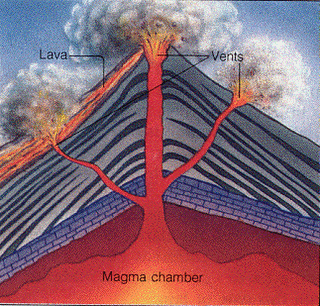Magma vs Lava: What's the difference?
- Magma is the molten rock that flows beneath the surface of the Earth
- Lava is magma that has reached the surface of the Earth.

How are volcanoes formed?
- Volcanoes are formed by a magma vent burning through the Earth's crust allowing molten rock to flow upwards through the newly created magma channel.
- The magma rises up small channels from deep within the Earth, often occurring at tectonic plate boundaries.
- Tectonic plates are also responsible for earthquakes and many times the plate movement that causes a volcano to erupt will also cause an earthquake.
- The recent eruption of Kilauea this summer had a 6.9 magnitude earthquake that also resulted from tectonic plate movement.
- These plates move towards and away from one another; volcanoes are the result of two tectonic plates meeting or pulling away from each other. allowing magma that lies flows beneath the plates to rise through the Earth's crust and form a volcano on the surface.
- The movement of the plates below the rupture can allow for magma to flow up into the volcano and form a lava pool that can then drain back into the Earth or it can cause the volcano to erupt depending on the movement of the plates and the gases beneath the surface of the Earth.
How hot is lava?
In this video researchers from the Syracuse Unversity created their own volcano that they then used to produce the lava that is seen in the video. They were experimenting with how quickly it would take to cook meat over the extreme temperatures of lava.
- The temperature of lava at Kilauea is about 2,140 degrees Fahrenheit
- The lava in the lava tubes beneath the surface of the Earth at Kilauea is about 2,200 degrees Fahrenheit
Safety Hazards Involving Volcanoes
- In addition to the obvious danger of flowing lava, a volcanic can also be the cause of or occur in conjunction with other safety hazards such as:
- Earthquakes- The eruption of a volcano often follows an earthquake as result of tectonic plate movement
- Tsunamis- Huge ocean disturbances caused by earthquakes and plate movement
- Gas emissions- Volcanoes can emit gases before, during, and after eruptions. These gases can be harmful to plant and animal life that inhale them in high concentrations. Common gases emitted are: Water Vapor, Carbon Dioxide, Sulfur Dioxide, Hydrogen Sulfide, and Hydrogen Halides.
- Acid rain- Volcanic gas emissions can also combine with other gases in the atmosphere to create acid rain.
Types of volcanoes
- Cinder Cones
- These are the simplest types of volcanoes; they are formed by the ash and lava chunks that erupt from a single vent within the volcano.
- Cinder cones often have a crater at the summit and tend to be shorter and smaller volcanoes and are common across North America.
- Stratovolcanoes or Composite Volcanoes
-
Tall and symmetrical volcanoes built by layers of lava flows, volcanic ash, etc.
- Mount Hood in Oregon, Mount Rainer and Mount St. Helens in Washington are all examples of stratovolcanoes.
- Crater Lake in Oregon is an example of a composite volcano that collapsed as result of a massive eruption that weakened the internal structure of the volcano. The caldera formed after the magma drained out of the central vent of the volcano and the summit collapsed inward to create the enormous crater that then filled with water and became Crater Lake.
-
- Shield Volcanoes
- Built almost entirely of lava flows forming a broad and relatively slowly sloping mountain. Many shield volcanoes are miles wide in diameter.
- Kilauea and Mauna Loa are examples of shield volcanoes in Hawaii.
- Lava Domes
- Lava domes are formed by lava flows too thick and viscous to flow down the side of the mountain so they form a pile around the lava vent. Eventually the lava will build up and cooled chunks will fall down the side of the mountain. Lava domes commonly form on the side of large stratovolcanoes.
Types of lava flows
- A'a
- rocky and chunky lava flow that forms sharp and rocky terrain when cooled
- formed by the flow of lava breaking the crust surface and forming sharp rocks
- Blocky
- similar to a'a but has larger chunks than a'a flow
- formed by the flow of lava breaking the crust surface and forming sharp rocks
- Pahoehoe
- gooey flow that forms cool and smoother rock when cooled
- lava flow that does not break the crust and forms a rope-like and continuous flow
- Pillow
- This type of lava flow occurs underwater at vents and rifts where lava comes through the crust and through the ocean floor.
- It forms a billowing and bubbly flow that has a pillow-like appearance

